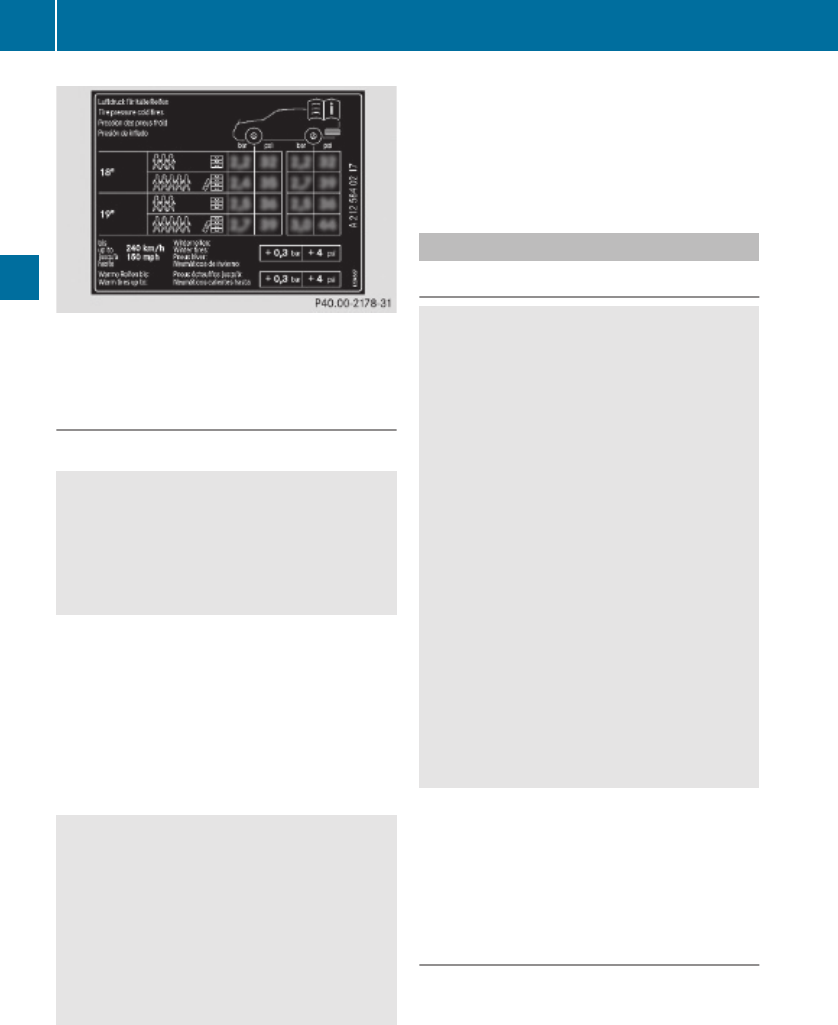
Example illustration: Tire inflation pressures
specific to rim diameter
Potential problems associated with
underinflated and overinflated tires
Underinflated tires
G
Warning!
Follow recommended tire inflation pressures.
Do not underinflate tires. Underinflated tires
wear excessively and/or unevenly, adversely
affect handling and fuel economy, and are
more likely to fail from being overheated.
Underinflated tires can
R
cause excessive and uneven tire wear
R
adversely affect fuel economy
R
lead to tire failure from being overheated
R
adversely affect handling characteristics
Overinflated tires
G
Warning!
Follow recommended tire inflation pressures.
Do not overinflate tires. Overinflated tires can
adversely affect handling and ride comfort,
wear unevenly, increase stopping distance,
and result in sudden deflation (blowout)
because they are more likely to become
punctured or damaged by road debris,
potholes etc.
Overinflated tires can
R
adversely affect handling characteristics
R
cause uneven tire wear
R
be more prone to damage from road
hazards
R
adversely affect ride comfort
R
increase stopping distance
Checking tire inflation pressure
Safety notes
G
Warning!
Follow recommended tire inflation pressures.
Do not underinflate tires. Underinflated tires
wear excessively and/or unevenly, adversely
affect handling and fuel economy, and are
more likely to fail from being overheated.
Do not overinflate tires. Overinflated tires can
adversely affect handling and ride comfort,
wear unevenly, increase stopping distance,
and result in sudden deflation (blowout)
because they are more likely to become
punctured or damaged by road debris,
potholes etc.
Do not overload the tires by exceeding the
specified load limit as indicated on the Tire
and Loading Information placard on the
driver’s door B-pillar. Overloading the tires
can overheat them, possibly causing a
blowout. Overloading the tires can also result
in handling or steering problems, or brake
failure.
Check the tire inflation pressure at least once
a month.
Check and adjust the tire inflation pressure
when the tires are cold (Y page 230).
Checking tire inflation pressure
manually
Follow the steps below to achieve correct tire
inflation pressure:
X
Remove the cap from the valve on one tire.
X
Firmly press a tire gauge onto the valve.
X
Read the tire inflation pressure on the tire
gauge and check against the
recommended tire inflation pressure on the
232
Tires and wheels
Operation
204_AKB; 5; 23, en-US
d2ureepe, Version: 2.11.8.1
2009-07-16T17:54:06+02:00 - Seite 232


















